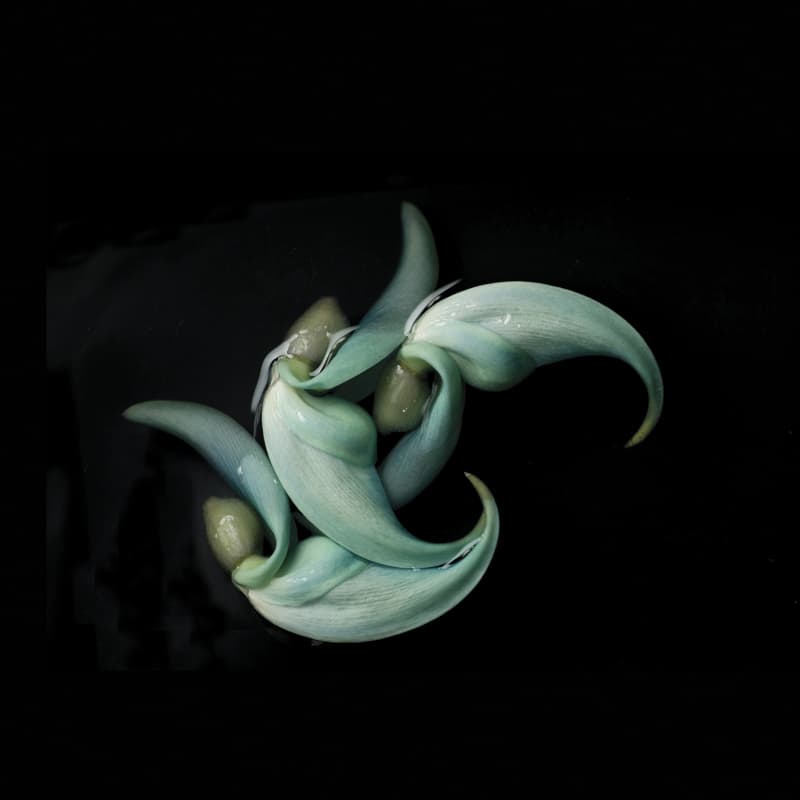Photo Insight with Heather Angel

An internationally renowned photographer of the natural world and author of more than 50 books, Heather brings her expertise to AP.
The flowers you see here come from a plant called a jade vine, which is also referred to as an emerald vine. I had been photographing the vine in a British tropical glasshouse, although the plant is actually native to the Philippines and only grows besides streams in damp forests or in ravines. It’s a tropical specimen that displays a long cascade of flowers, many of which fall to the ground each day, meaning that the ground beneath the vine is littered with beautiful little objects.
I collected a handful of the flowers and was immediately struck by their curves and beaks. I decided to take them back to my studio, although I wasn’t sure what I was going to do with them – I just knew that I had to photograph them. When I was studying the flowers I began to wonder if they would float. It was an obvious connection for me due to the nature and damp environment of the jade vine. I had photographed flowers floating on water before, but never anything as unusual as this so it was a task I took to with great enthusiasm.
I found a shallow vessel, probably not much bigger than a large fish tank, and laid a sheet of black Formica along the bottom. Formica is a heat-resistant, wipe-clean, plastic laminate – basically the kind of thing that you can find lining many kitchen worktops. If anyone wishes to attempt a shot like this, the material doesn’t have to be Formica. You can use any kind of material so long as it’s a non-wettable matt black.
Once I had the vessel in place, I filled it with water, placed the flowers on the surface and waited for the water to settle. What was intriguing was that I had originally placed the flowers separately on the water, but very quickly they came together to form this little group that looked extraordinarily alien. In fact, the whole image looks like some strange creature floating in the empty void of space. I can only assume the beaks that curved beneath the surface caused a dip in the water that drew them all together.

To light the shot I used a tool that I have been using quite a lot over the past year – a Honi softbox. I have a lot of large softboxes with professional lights that I use in the studio, but the Honi softbox is a small portable piece of kit that you attach to your flashgun. It’s a brilliant and convenient way to light your shots. For photographs similar to this I sometimes find myself using a Sto-Fen diffuser, which also attaches to your flashgun, but for this particular shot the 8in (20cm) diameter of the Honi gave me the soft, even spread of light that I needed.
Something that was crucial to think about was the placement of the camera and flash. I mounted my Nikon D3 DSLR on a tripod – although I could also have used a Cambo copy stand – and angled my camera so that it was looking straight down on the flowers.
The most important thing to note here is that the flash – a Nikon SB-900 Speedlight – was off-camera. If you have a camera with a flash attached looking down onto a reflective surface, such as water or glass, then you’re going to get a lot of light bouncing off the surface and into the lens. For this shot, I had the flash on an extension lead and off to the top-left. I then shot the image at 1/200sec at f/7 and ISO 250.
One of the most striking things about this shot, and about jade vine flowers in general, is their beautiful colour. It’s a difficult colour to describe. Some call it turquoise – in fact, it’s often referred to as a turquoise jade vine – although I think it’s a more attractive tone than that. It’s one of those colours that you often find in natural subjects where the colours seem to look different to everyone. I’ve photographed jade vines over many years in different places, and sometimes it will be more of a blue colour while on other occasions there will be strong hints of green.
This is one of those images that raises an interesting point about the kinds of considerations that a photographer – particularly one who has been commissioned – will sometimes have to make when shooting images. To take this image of the jade vine flowers as an example, the fact that the background is completely black means there is a lot of negative space to play with and I can tell that the image would potentially look lovely on the page of a magazine or in a book.
With that in mind I can add more black to the top and bottom of the image in post-production. That will make the rectangular image into a square. The reason I would potentially do this is that a square, from a design point of view, is a lot more pleasing. It gives the art department at a magazine or publisher more options regarding design. A square is a lot easier to work with than a rectangle. Whenever you can, plan ahead and think about how your image could potentially be used.
Heather Angel was talking to Oliver Atwell

To see more images by Heather visit www.heatherangel.co.uk or www.naturalvisions.co.uk. Heather regularly runs workshops at the British Wildlife Centre. For information on courses run by Heather and her son Giles, visit www.photographyandphotoshopcourses.co.uk







